Dutch famine of 1944–45
The Dutch famine of 1944–45, known in the Netherlands as the Hongerwinter (literal translation: hunger winter), was a famine that took place in the German-occupied Netherlands, especially in the densely populated western provinces north of the great rivers, during the winter of 1944–45, near the end of World War II.
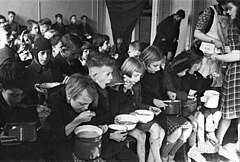
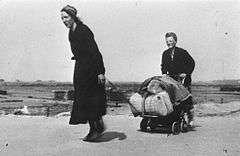
A German blockade cut off food and fuel shipments from farm towns. Some 4.5 million were affected and survived thanks to soup kitchens. Loe de Jong (1914–2005), author of The Kingdom of the Netherlands During World War II, estimated at least 22,000 deaths occurred due to the famine.[1] Another author estimated 18,000 deaths from the famine.[2][3] Most of the victims were reportedly elderly men.[4][5]
The famine was alleviated by the liberation of the provinces by the Allies in May 1945. Prior to that, bread baked from flour shipped in from Sweden, and the airlift of food by the Royal Air Force, the Royal Canadian Air Force, and the United States Army Air Forces – under an agreement with the Germans that if the Germans did not shoot at the mercy flights, the Allies would not bomb the German positions – helped to mitigate the famine. These were Operations Manna and Chowhound. Operation Faust also trucked in food to the province.
Causes
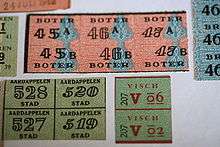
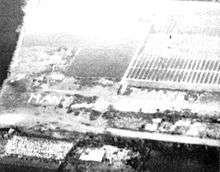
Towards the end of World War II, food supplies became increasingly scarce in the Netherlands. After the landing of the Allied Forces on D-Day, conditions became increasingly bad in the Nazi-occupied Netherlands. The Allies were able to liberate the southern part of the country, but ceased their advance into the Netherlands when Operation Market Garden, the attempt to seize a bridge across the Rhine at Arnhem, failed.
The Allied advance into Germany was delayed by supply problems as the port of Antwerp was not usable until the approaches had been cleared in the Battle of the Scheldt. But Montgomery had given priority to "Market Garden"; and to the capture of the French Channel ports like Boulogne, Calais and Dunkirk, which were resolutely defended and had suffered demolitions, see Operation Market Garden .[6]
After the national railways complied with the exiled Dutch government's appeal for a railway strike starting September 1944 to further the Allied liberation efforts, the German administration (under Wehrmachtbefehlshaber Friedrich Christiansen) retaliated by placing an embargo on all food transports to the western Netherlands. By the time the embargo was partially lifted in early November 1944, allowing restricted food transports over water, the unusually early and harsh winter had already set in. The canals froze over and became impassable for barges.
Food
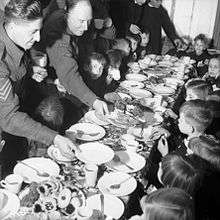

Food stocks in the cities in the western Netherlands rapidly ran out. The adult rations in cities such as Amsterdam dropped to below 1000 calories (4,200 kilojoules) a day by the end of November 1944 and to 580 calories in the west by the end of February 1945.[7] Over this Hongerwinter ("Hunger winter"), a number of factors combined to cause starvation in especially the large cities in the West of the Netherlands. The winter in the month of January 1945 itself was unusually harsh prohibiting transport by boat for roughly a month between early January 1945 and early February 1945. Also, the German army destroyed docks and bridges to flood the country and impede the Allied advance. Thirdly, Allied bombing made it extremely difficult to transport food in bulk, since Allied bombers could not distinguish German military and civilian shipments. As the south-eastern (the Maas valley) and the south-western part of the Netherlands (Walcheren and Beveland) became one of the main western battlefields, these conditions combined to make the transport of existing food stocks in large enough quantities nearly impossible.
The areas affected were home to 4.5 million people. Butter disappeared after October 1944, shortly after railway transport to the western parts of the Netherlands had stopped in September due to the railway strike. The supply of vegetable fats dwindled to a minuscule seven-month supply of 1.3 liters per person. At first 100 grams of cheese were allotted every two weeks; the meat coupons became worthless. The bread ration had already dropped from 2,200 to 1,800 and then to 1,400 grams per week. Then it fell to 1,000 grams in October, and by April 1945 to 400 grams a week. Together with one kilogram of potatoes, this then formed the entire weekly ration. The black market increasingly ran out of food as well, and with the gas and electricity and heat turned off, everyone was very cold and very hungry.[8] In search of food, young strong people would walk for tens of kilometers to trade valuables for food at farms. Tulip bulbs and sugar beets were commonly consumed. Furniture and houses were dismantled to provide fuel for heating.
In the last months of 1944, in anticipation of the coming famine, tens of thousands of children were brought from the cities to rural areas where many remained until the end of the war. Deaths in the three big cities of the Western Netherlands (The Hague, Rotterdam, and Amsterdam) started in earnest in December 1944, reaching a peak in March 1945,[9] but remained very high in April and May 1945. In early summer 1945 the famine was brought quickly under control. From September 1944 until May 1945 the deaths of 18,000 Dutch people were attributed to malnutrition as the primary cause and in many more as a contributing factor.[7]
End of the famine
The Dutch Famine ended with the liberation by the Allies of the western Netherlands in March 1945. Shortly before that, some relief had come from "Swedish bread", which was baked in the Netherlands from flour shipped in from Sweden. Shortly after these shipments, the German occupiers allowed coordinated air drops of food over German-occupied Dutch territory by the Royal Air Force and Royal Canadian Air Force from 29 April to 7 May (Operation Manna), and by the U.S. Army Air Forces from 1 to 8 May (Operation Chowhound). The Germans agreed not to shoot at the planes flying the mercy missions, and the Allies agreed not to bomb German positions. Operation Faust also trucked in food to Rhenen beginning on 2 May, utilizing 200 vehicles. Rhenen was also occupied by the Germans.
Legacy
The Dutch famine of 1944–45 was a rare case of a famine which took place in a modern, developed, and literate country, albeit one suffering under the privations of occupation and war. The well-documented experience has helped scientists to measure the effects of famine on human health.
The Dutch Famine Birth Cohort Study[10] found that the children of pregnant women exposed to famine were more susceptible to diabetes, obesity, cardiovascular disease, microalbuminuria and other health problems.[11]
Moreover, the children of the women who were pregnant during the famine were smaller, as expected. However, surprisingly, when these children grew up and had children those children were thought to also be smaller than average.[12] This data suggested that the famine experienced by the mothers caused some kind of epigenetic changes that were passed down to the next generation. Despite this, a subsequent study by the same author failed to find a correlation between maternal exposure to famine and birth weight of the next generation.[13]
The discovery of the cause of coeliac disease may also be partly attributed to the Dutch famine. With wheat in very short supply there was an improvement at a children's ward of coeliac patients. Stories tell of the first precious supplies of bread being given specifically to the (no longer) sick children, prompting an immediate relapse. Thus in the 1940s the Dutch paediatrician Dr. Willem Dicke[14] was able to corroborate his previously researched hypothesis that wheat intake was aggravating coeliac disease.[15] Later Dicke went on to prove his theory.
Audrey Hepburn spent her childhood in the Netherlands during the famine and despite her later wealth she had lifelong negative medical repercussions. She suffered from anemia, respiratory illnesses, and œdema as a result.[16]
Subsequent academic research on the children who were affected in the second trimester of their mother's pregnancy found an increased incidence of schizophrenia in these children.[17] Also increased among them were the rates of schizotypal personality and neurological defects.[18]
Some studies have suggested that epigenetic damage caused by the famine has caused increased morbidity in the grandchildren of Hongerwinter survivors.[19]
See also
- Effect of the Siege of Leningrad on the city
- Great famine of 1941–42, in German-occupied Greece
- Historical trauma
- Holodomor in Ukraine
- Hunger Plan
- List of famines
- Överkalix study
- Prenatal nutrition and birth weight
- Siege of Leningrad
- Transgenerational epigenetics
References
Notes
- "Uitzending Gemist – Vroeger & Zo De hongerwinter – 1944" (video) (in Dutch). Retrieved 21 July 2012.
- van der Zee, Henri A. (1998), The Hunger Winter: Occupied Holland 1944–1945, University of Nebraska Press, pp. 304–05.
- Barnouw, David (1999), De hongerwinter, p. 52, ISBN 9789065504463
- Banning, C. (1946), "Food Shortage and Public Health, First Half of 1945", Annals of the American Academy of Political and Social Science, 245 (The Netherlands during German Occupation (May 1946)): 93–110, doi:10.1177/000271624624500114, JSTOR 1024809
- "Slachtoffers Hongerwinter in kaart gebracht". nos.nl (in Dutch).
- Beevor, Antony (2014) [2012]. The Second World War. London: Weidenfeld & Nicolson. p. 766. ISBN 978-1-7802-2564-7.
- Z. Stein, (1975). Famine and Human Development: The Dutch Hunger Winter of 1944–1945.
- Banning (1946), p 93
- The number of officially reported extra deaths in March 1945 in The Hague alone was 1,380; part of this number probably also included identified victims from Allied bombardments (550 deaths on March 2 (see Bombing of the Bezuidenhout) and German reprisals, on the other hand not all extra deaths were included in this number (in a bureaucracy there is no death without a(n identified) body).
- Carried out by the departments of Clinical Epidemiology and Biostatistics, Gynecology and Obstetrics and Internal Medicine of the Academic Medical Centre in Amsterdam, in collaboration with the MRC Environmental Epidemiology Unit of the University of Southampton in Britain.
- Dutch Famine of 1944 (bibliography), HK: UST, archived from the original on 19 February 2007, retrieved 19 February 2007.
- Painter, RC; Osmond, C; Gluckman, P; Hanson, M; Phillips, DI; Roseboom, TJ (September 2008). "Transgenerational effects of prenatal exposure to the Dutch famine on neonatal adiposity and health in later life". BJOG : An International Journal of Obstetrics and Gynaecology. 115 (10): 1243–9. doi:10.1111/j.1471-0528.2008.01822.x. PMID 18715409.
- Stein, AD; Lumey, LH (August 2000). "The relationship between maternal and offspring birth weights after maternal prenatal famine exposure: the Dutch Famine Birth Cohort Study". Hum. Biol. 72 (4): 641–54. PMID 11048791.
- van Berge-Henegouwen, G; Mulder, C (1993). "Pioneer in the gluten free diet: Willem-Karel Dicke 1905–1962, over 50 years of gluten free diet" (PDF). Gut. 34 (11): 1473–5. doi:10.1136/gut.34.11.1473. PMC 1374403. PMID 8244125.
- Dicke, WK (1950), Coeliakie: een onderzoek naar de nadelige invloed van sommige graansoorten op de lijder aan coeliakie (PhD thesis), Utrecht, NL: University of Utrecht.
- Garner, Lesley (26 May 1991), "Lesley Garner meets the legendary actress as she prepares for this week's Unicef gala performance", The Sunday Telegraph, archived from the original on 17 January 2005.
- Brown, AS; Susser, ES (November 2008). "Prenatal Nutritional Deficiency and Risk of Adult Schizophrenia". Schizophr Bull. 34 (6): 1054–63. doi:10.1093/schbul/sbn096. PMC 2632499. PMID 18682377.
- Walker, Elaine E; Cicchetti, Dante (2003). Neurodevelopmental mechanisms in psychopathology. Cambridge, UK: Cambridge University Press. pp. 88–93. ISBN 978-0-521-00262-2.
- Mukherjee, Siddhartha (2 May 2016). "Breakthroughs in Epigenetics". The New Yorker. Archived from the original on 23 July 2018.
A decade ago, when the grandchildren of men and women exposed to the famine were studied, they, too, were reported to have had higher rates of illness.
Bibliography
- Banning, C. (May 1946). "Food Shortage and Public Health, First Half of 1945". Annals of the American Academy of Political and Social Science. Vol. 245, The Netherlands during German Occupation, pp. 93–110. (JSTOR.)
- Barnouw, David (1999). De hongerwinter. ISBN 978-9065504463.
- Bijvoet, Tom and Van Arragon Hutten, Anne (2013). The Hunger Winter. ISBN 978-0-9868308-9-1.
- Collingham, E. M. (2011). The Taste of War: World War Two and the Battle for Food.
- de Jong, Loe. The Kingdom of the Netherlands During World War II (vol VII), p. 1–270 (Verarmend Nederland, 1914–2005)
- Hart, Nicky. "Famine, Maternal Nutrition and Infant Mortality: A Re-Examination of the Dutch Hunger Winter", Population Studies Vol. 47, No. 1 (March 1993), pp. 27–46 (JSTOR)
- Hitchcock, William I. (2009). The Bitter Road to Freedom: The Human Cost of Allied Victory in World War II Europe. pp. 98–129.
- Sas, Anthony. "Holland's 'Hunger Winter' of 1944–45", Military Review, September 1983, Vol. 63, Issue 9, pp. 24–32.
- Sellin, Thorsten (ed.) (May 1946). "The Netherlands During German Occupation", Annals of the American Academy of Political and Social Science Vol. 245, pp. i to 180. (JSTOR.)
- Stein, Zena (ed.) (1975). Famine and human development: The Dutch hunger winter of 1944–1945.
- van der Zee, Henri A. (1998). The Hunger Winter: Occupied Holland 1944–1945. University of Nebraska Press.
- Warmbrunn, Werner (1963). The Dutch Under German Occupation 1940–1945. Stanford University Press.
External links
| Wikimedia Commons has media related to Hungerwinter. |
- Dutch film (starting at minute 2:00)
- The Dutch Famine Birth Cohort Study
- Recipe for tulip-bulb puree at the Amsterdam City Archives
- The Hunger winter and the allied food relief that followed
Multimedia
- CBC Archives – CBC Radio (22 April 1945) reporting on the famine in Apeldoorn and the inflation of food prices.
- CBC Archives – CBC Radio (30 April 1945) reporting on the agreement to provide food to the Dutch.